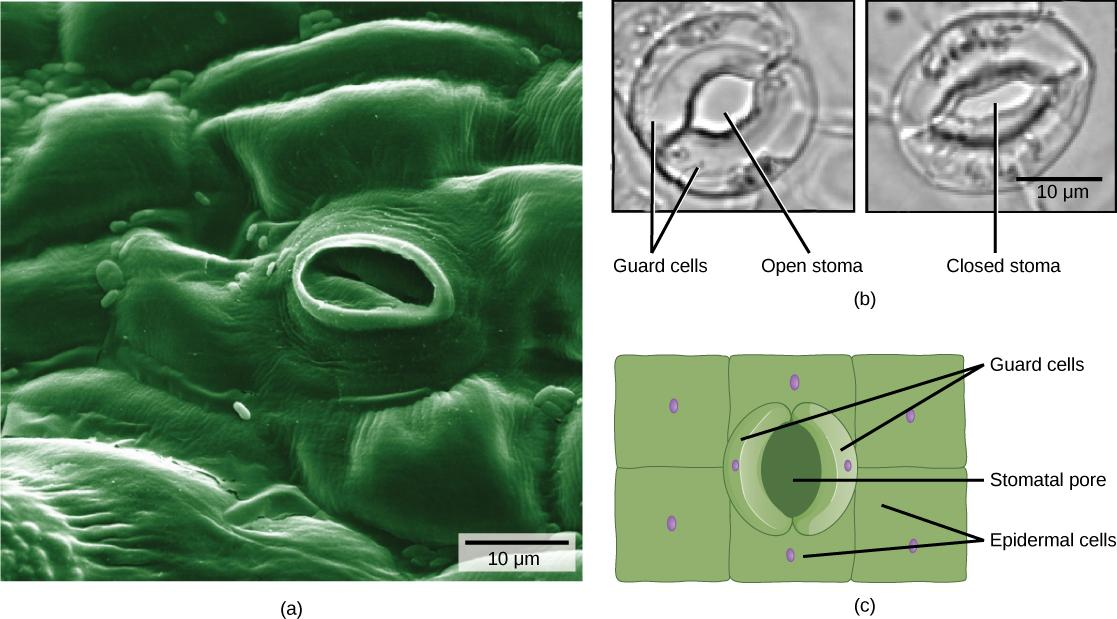
What is stomatal apparatus? Explain the structure of stomata with a labelled diagram.
Answer
420k+ views
Hint:Stomata is defined as the minute pores that is present in the leaves and stems of the plants. These are the organs of the transpiration in which the water is lost through it. This is also called the stomata apparatus which helps in the water and gaseous exchange.
Complete answer:
Guard cells are the bean shaped cells present in the leaves and have the potassium ions in it. But in grasses the guard cells are dumb- bell shaped. The pore space formed within these cells is called stomata. Transpiration is the process by which the water is lost through the stomatal openings. This opening and the closing of the stomata is controlled by the guard cells surrounding the pores of the stomata in the leaves. Transport of potassium in the guard cells maintains the turgor pressure in the guard cells, this helps in the opening or the closing of the stomata.
(1) Opening of stomata
Guard cells are full of potassium ions and in order to balance it, water from the nearby guard cells enters into these guard cells. As the water enters, the guard cell becomes bulge and swollen. This process is called endosmosis. This increases the turgor pressure and makes the stomatal pores open.
(2) Closing of stomata
This occurs when the water from the guard cell moves out and the turgor pressure gets reduced. At this time guard cells become flaccid and the pores of the stomata closes. Transport of the potassium ion is responsible for the changes in the stomata opening and closing mechanism.

Note: Opening of stomata mainly occurs at the presence of sunlight and when the photosynthesis takes place. And the closing of the stomata is the opposite of the opening phenomenon. And the closing occurs at the time of night where there is absence of sunlight.
Complete answer:
Guard cells are the bean shaped cells present in the leaves and have the potassium ions in it. But in grasses the guard cells are dumb- bell shaped. The pore space formed within these cells is called stomata. Transpiration is the process by which the water is lost through the stomatal openings. This opening and the closing of the stomata is controlled by the guard cells surrounding the pores of the stomata in the leaves. Transport of potassium in the guard cells maintains the turgor pressure in the guard cells, this helps in the opening or the closing of the stomata.
(1) Opening of stomata
Guard cells are full of potassium ions and in order to balance it, water from the nearby guard cells enters into these guard cells. As the water enters, the guard cell becomes bulge and swollen. This process is called endosmosis. This increases the turgor pressure and makes the stomatal pores open.
(2) Closing of stomata
This occurs when the water from the guard cell moves out and the turgor pressure gets reduced. At this time guard cells become flaccid and the pores of the stomata closes. Transport of the potassium ion is responsible for the changes in the stomata opening and closing mechanism.

Note: Opening of stomata mainly occurs at the presence of sunlight and when the photosynthesis takes place. And the closing of the stomata is the opposite of the opening phenomenon. And the closing occurs at the time of night where there is absence of sunlight.
Recently Updated Pages
The correct geometry and hybridization for XeF4 are class 11 chemistry CBSE

Water softening by Clarks process uses ACalcium bicarbonate class 11 chemistry CBSE

With reference to graphite and diamond which of the class 11 chemistry CBSE

A certain household has consumed 250 units of energy class 11 physics CBSE

The lightest metal known is A beryllium B lithium C class 11 chemistry CBSE

What is the formula mass of the iodine molecule class 11 chemistry CBSE

Trending doubts
Why was the Vernacular Press Act passed by British class 11 social science CBSE

Arrange Water ethanol and phenol in increasing order class 11 chemistry CBSE

Name the nuclear plant located in Uttar Pradesh class 11 social science CBSE

One Metric ton is equal to kg A 10000 B 1000 C 100 class 11 physics CBSE

What steps did the French revolutionaries take to create class 11 social science CBSE

How did silk routes link the world Explain with three class 11 social science CBSE




